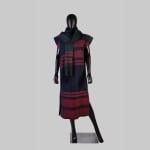Margaret Roach Wheeler
Old-Style Navajo Dress with Shawl
Copyright The Artist
Further images
-
(View a larger image of thumbnail 1
)

-
(View a larger image of thumbnail 2
)

-
(View a larger image of thumbnail 3
)

-
(View a larger image of thumbnail 4
)

-
(View a larger image of thumbnail 5
)

-
(View a larger image of thumbnail 6
)

-
(View a larger image of thumbnail 7
)

-
(View a larger image of thumbnail 8
)

Native Couture is a name that I gave to clothes I was creating for sale in the Indian markets. They were for customers to wear in their everyday lives. —Margaret...
Native Couture is a name that I gave to clothes I was creating for sale in the Indian markets. They were for customers to wear in their everyday lives.
—Margaret Roach Wheeler
The old-style Navajo dress is based on the biil (pronounced ‘beel’), also known as a blanket dress. Two identically woven panels are sewn together with openings left for the neck and arms. The biil was the standard dress worn by Navajo/Diné women before the Long Walk—Christopher ‘Kit’ Carson’s scorched-earth campaign that burned villages and slaughtered livestock across across the Navajo/Diné homelands. With the loss of the sheep that had been the source of both food and fiber, the scarcity of fine wool from the Navajo-Churro sheep gave way to the new dress style influenced by the Victorian dresses of the European women in the forts.
—Margaret Roach Wheeler
The old-style Navajo dress is based on the biil (pronounced ‘beel’), also known as a blanket dress. Two identically woven panels are sewn together with openings left for the neck and arms. The biil was the standard dress worn by Navajo/Diné women before the Long Walk—Christopher ‘Kit’ Carson’s scorched-earth campaign that burned villages and slaughtered livestock across across the Navajo/Diné homelands. With the loss of the sheep that had been the source of both food and fiber, the scarcity of fine wool from the Navajo-Churro sheep gave way to the new dress style influenced by the Victorian dresses of the European women in the forts.







